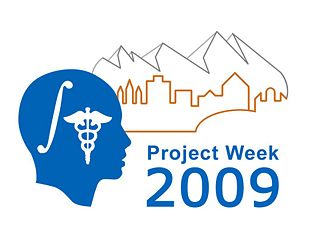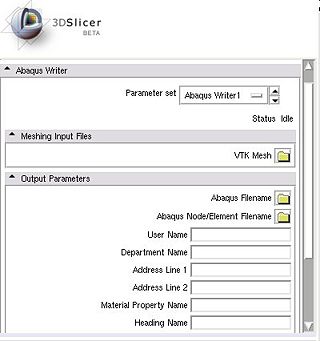Difference between revisions of "2008 Winter Project Week:Meshing Techniques into NA-MIC Toolkit"
m |
|||
| (4 intermediate revisions by the same user not shown) | |||
| Line 1: | Line 1: | ||
{| | {| | ||
|[[Image:NAMIC-SLC.jpg|thumb|320px|Return to [[2008_Winter_Project_Week]] ]] | |[[Image:NAMIC-SLC.jpg|thumb|320px|Return to [[2008_Winter_Project_Week]] ]] | ||
| − | + | |[[Image:AbaqusExport.jpg|thumb|320px|Mesh Exporting]] | |
| + | |valign="top"| | ||
|} | |} | ||
__NOTOC__ | __NOTOC__ | ||
===Key Investigators=== | ===Key Investigators=== | ||
| − | * University of Iowa: Nicole Grosland , Vince Magnotta, Kiran Shivanna | + | * University of Iowa: Nicole Grosland , Vince Magnotta, Kiran Shivanna |
| Line 14: | Line 15: | ||
<h1>Objective</h1> | <h1>Objective</h1> | ||
| − | The University of Iowa has developed a complete Finite Element meshing workflow to operates from image source through to FE simulation | + | The University of Iowa has developed a complete Finite Element meshing workflow to operates from image source through to FE simulation. For this project, we will be creating new Slicer3 execution model programs to support the meshing workflow and to expand the current meshing capabilities. |
| + | |||
</div> | </div> | ||
| Line 21: | Line 23: | ||
<h1>Approach, Plan </h1> | <h1>Approach, Plan </h1> | ||
| − | + | Two tools will be developed to help support the meshing workflow. This includes the following: | |
| + | 1) Tool for material property assignment for mesh elements using imaging data, and 2) Tool to export VTK unstructured grids to the ABAQUS format. Start the development of an execution model for a mapped meshing algorithm that registers a template mesh to a target surface | ||
</div> | </div> | ||
| Line 28: | Line 31: | ||
<h1>Progress</h1> | <h1>Progress</h1> | ||
| − | + | A utility for exporting the solid meshes to Abaqus format have been developed as a Slicer3 execution model program. This work was tested using existing meshes that have been developed in IA-FEMesh. Work has started on a utility for the assignment of elementwise material properties. This is currently being tested. Finally, the finite element mapped meshing is currently being converted to a Slicer3 execution model. This work continue over the next few months. | |
| − | |||
| − | |||
| − | |||
| − | |||
| − | |||
| − | |||
| − | |||
| − | |||
| − | |||
| − | |||
| − | |||
</div> | </div> | ||
| Line 49: | Line 41: | ||
===References=== | ===References=== | ||
| − | |||
Latest revision as of 19:46, 10 January 2008
Home < 2008 Winter Project Week:Meshing Techniques into NA-MIC Toolkit Return to 2008_Winter_Project_Week |
Key Investigators
- University of Iowa: Nicole Grosland , Vince Magnotta, Kiran Shivanna
Objective
The University of Iowa has developed a complete Finite Element meshing workflow to operates from image source through to FE simulation. For this project, we will be creating new Slicer3 execution model programs to support the meshing workflow and to expand the current meshing capabilities.
Approach, Plan
Two tools will be developed to help support the meshing workflow. This includes the following: 1) Tool for material property assignment for mesh elements using imaging data, and 2) Tool to export VTK unstructured grids to the ABAQUS format. Start the development of an execution model for a mapped meshing algorithm that registers a template mesh to a target surface
Progress
A utility for exporting the solid meshes to Abaqus format have been developed as a Slicer3 execution model program. This work was tested using existing meshes that have been developed in IA-FEMesh. Work has started on a utility for the assignment of elementwise material properties. This is currently being tested. Finally, the finite element mapped meshing is currently being converted to a Slicer3 execution model. This work continue over the next few months.
